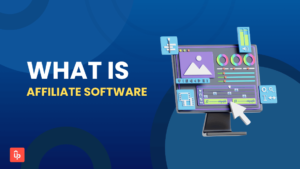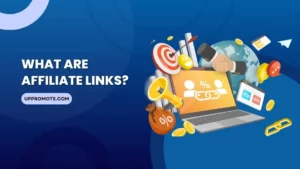Getting affiliates on board is just the beginning. The real challenge is turning them into long-term partners—those who consistently promote your brand, work transparently, and help drive reliable revenue. That’s why affiliate program management, done the right way, matters.
To do it well, you need two things: a clear strategy and the right tool to support it.
In this guide, we’ll walk you through 8 key tactics to help you manage affiliates more effectively:
- Recruit and Segment Affiliates to the Right Program
- Onboard Affiliates and Provide Training
- Empower Affiliates with Marketing Resources and Dashboards
- Track and Optimize Affiliate Performance
- Communicate and Build Strong Relationships
- Incentivize and Reward Affiliates
- Prevent Fraud and Manage Risks
- Address Legal and Compliance Considerations
Of course, handling all of this manually becomes impossible as your program grows. It might work when you have just a few affiliates, but what about dozens, or even hundreds?
Training, tracking commissions, segmenting partners, communicating at scale, detecting fraud—these tasks quickly pile up and leave room for error.
That’s where affiliate management software makes all the difference. The right solution helps you simplify onboarding, track performance in real time, send bonuses effortlessly, streamline communication, and stay fully in control, without burning out your team.
Looking to better your affiliate management process? Try UpPromote, a top-trusted Shopify affiliate solution for growth, with a 4.9/5 rating and over 2,500 reviews, designed to help you manage affiliates effortlessly.
Join 115,000+ UpPromote users to take full control of your affiliate programs for the best results.
What Is Affiliate Program Management?
Affiliate program management is the process of overseeing and optimizing an affiliate campaign to meet your business goals.
A wide range of tasks and responsibilities come with this role. The main activities include:
- Recruiting and training affiliates
- Tracking affiliate sales and paying commissions
- Building relationships with affiliates through communication, support, and recognition
- Ensuring affiliate promotional activities follow the program’s rules and brand values
- Analyzing affiliate performance and working on improvements
With effective affiliate management, you can harvest outstanding benefits such as:
- Boost affiliate performance
- Strengthen partnerships with your partners (affiliates, influencers, ambassadors, etc.)
- Scale your affiliate program by time
- Make data-driven decisions in optimizing your affiliate campaign
Common Challenges in Affiliate Marketing Management
Managing your partners and your affiliate campaign can be challenging. If not handled well, it can hurt your program’s success.
Here are common difficulties in running an affiliate program:
Finding the right partners
Not all affiliates fit your audience or deliver great results. Meanwhile, top affiliates are often in high demand and may already be partnered with competitors.
Screening affiliates who match your brand values and standards takes time and effort.
Tracking and attribution issues
Without a reliable affiliate tracking software, tracking referral orders and properly attributing them to affiliates can be tricky.
Customers often switch devices or click multiple links before buying. Ad blockers and privacy settings can disrupt cookie-based tracking.
Maintaining regular communication
As your program grows, it can be hard to keep in touch with a large base of affiliates.
Differences in time zones, languages, and affiliate engagement levels make communication more difficult.
Ensuring compliance and brand consistency
Affiliates may use spammy tactics or make false claims about your products. This could harm your brand and lead to legal troubles.
Fraud prevention
Some affiliates may fraudulently manipulate the system. They may use fake clicks, fake leads, cookie stuffing, or affiliate hijacking.
These scams can harm your program’s accuracy and cut into your profits.
Payment management
Managing multiple payment structures with varying rates is tough.
Payment delays or mistakes may cause dissatisfaction and distrust among affiliates.
Disputes over earnings can also arise due to misunderstandings or errors in commission calculations.
Market saturation and competition
In fact, over 80% of brands worldwide use affiliate marketing (Rakuten). Standing out in this crowded marketplace can be tough.
With many affiliates promoting similar products, the market is saturated. Competing with other businesses for the attention of top affiliates adds another challenge.
How to Manage Affiliates: 8 Effective Tactics
A good affiliate manager must do more than just create an affiliate program. To thrive in affiliate marketing, you need to manage it strategically for better outcomes.
1. Recruit and Segment Affiliates to the Right Program
Finding the right affiliate partners is key. But it can be hard to manage them.
Don’t think all affiliates are the same. The truth is they can be very different. This is why it’s necessary to understand affiliate types.
Knowing the types of affiliates can help you pick the best partners for your business. This way, you can also develop strategies to make the most of their strengths.
Five popular affiliate types you should know:
- Social media KOLs/ influencers
- Bloggers
- Function-based affiliates
- Management agency partners
- Email/ newsletter publishers
Type 1: Social media KOLs/ influencers
These are probably the most well-known types of affiliates. They are individuals with a huge following and credibility on social media.
According to the number of followers, four popular types of influencers are:
- Mega-influencers: With over a million followers (also known as celebrities)
- Macro-influencers: Have 100,000 to 1 million followers
- Micro-influencers: Typically range between 10,000 and 100,000 followers
- Nano-influencers: Have 1,000 to 10,000 followers
These influencers usually post stories, videos, or posts with affiliate links or coupon codes to promote your products.

They can also add a link in their bios. Their followers can click it anytime, then visit the brand’s site and buy the recommended products.
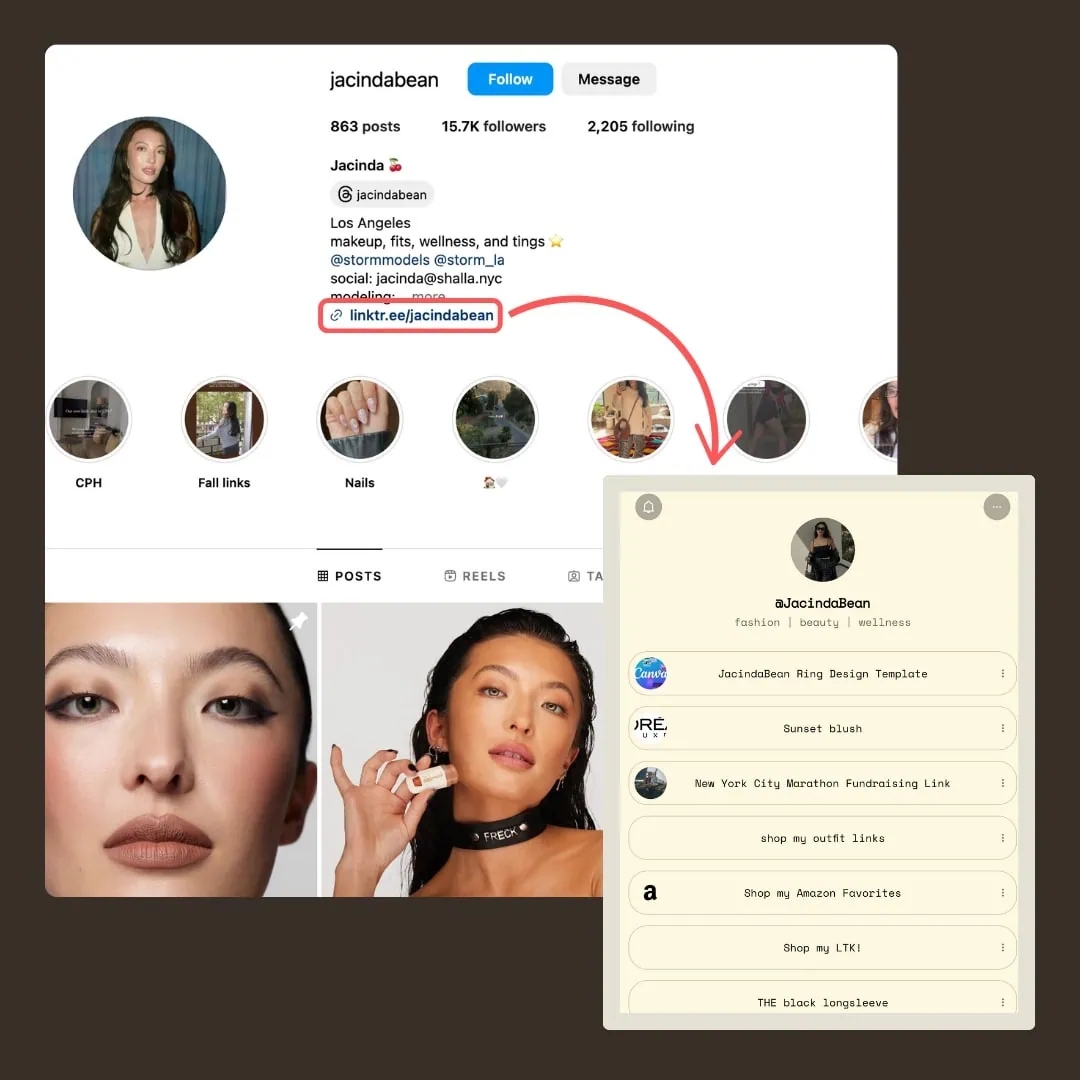
With a large number of followers and a good reputation, KOLs or influencers can provide your brands with a notably greater reach. But the more famous they are, the higher the cost of working with them.
So, think carefully about your budget, company size, and campaign goals to choose the right type of influencer.
To recruit them, you can:
- Share your program on Instagram, Facebook, or Twitter to enhance the chances that potential partners will find it.
- Use keywords and hashtags to find aligned influencers on social media.
- Join affiliate platforms like ShareASale, Impact, or UpPromote’s Marketplace. They connect you with niche influencers you want to reach.
Type 2: Bloggers
Bloggers write articles, reviews, and tutorials on their own websites. They attract readers who are interested in specific topics or industries.
If you sell kitchenware, food products or run a culinary brand, for instance, you can consider Pinch of Yum. This popular food blog features delicious recipes, cooking tips, and food photography. Its engaging content and strong community make it a great fit for your business.
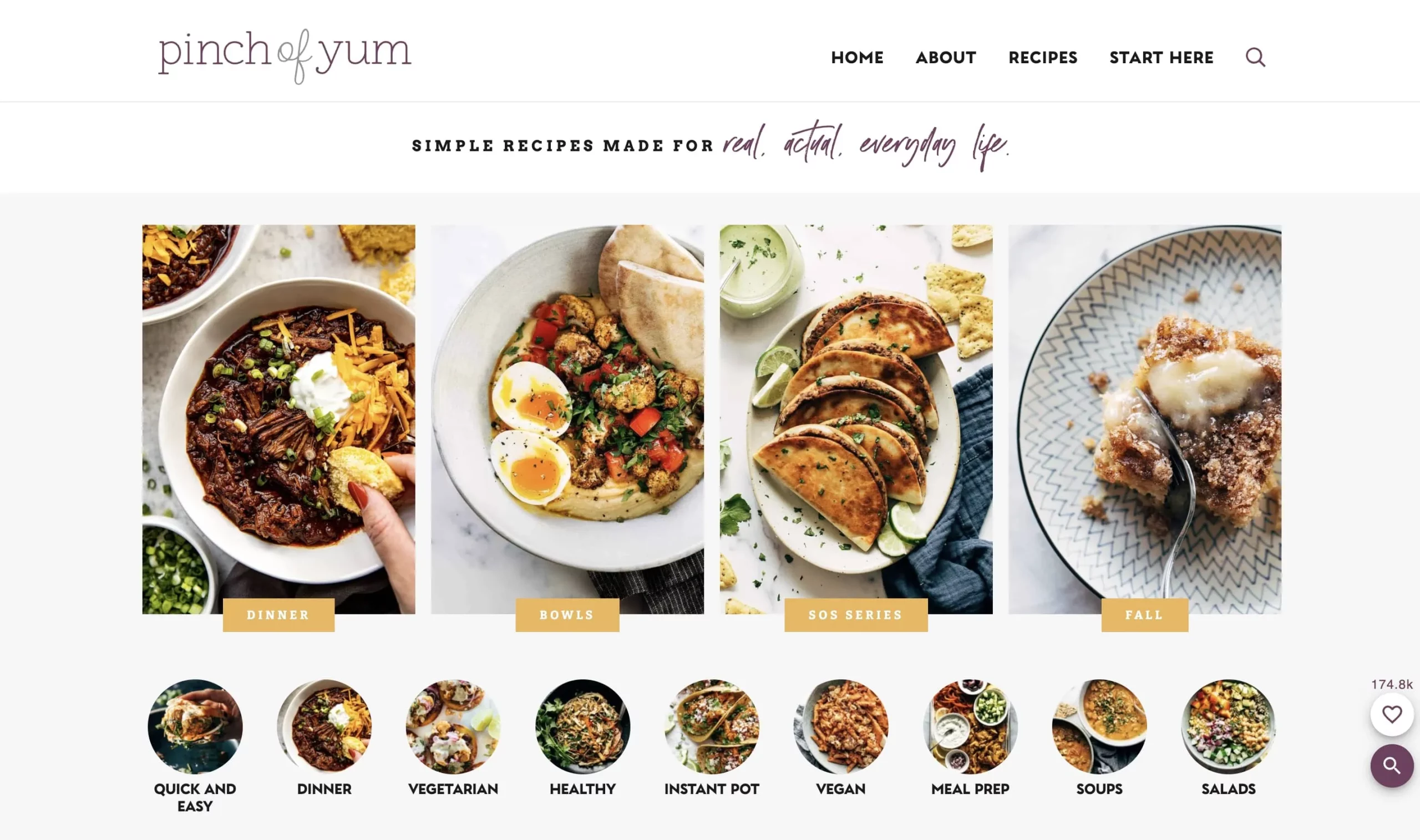
To find bloggers, there are some ways you can consider:
- Promote your affiliate program on your website. Create a dedicated affiliate signup page and place it where it’s easy to find. Optimize it for SEO or run ads to attract potential partners.
- Use Google search with relevant keywords within your niche to look for the ideal ones.
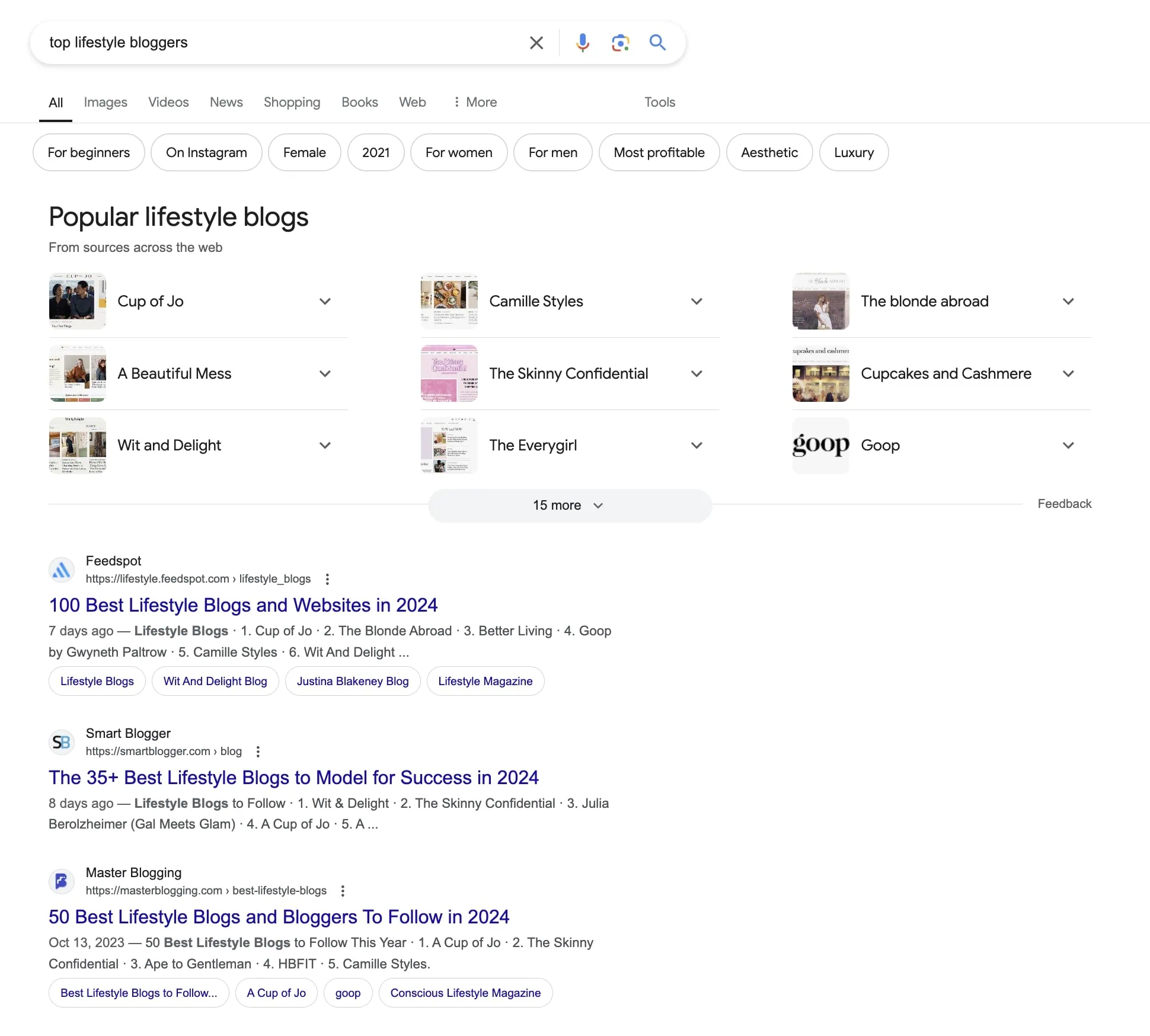
Type 3: Function-based affiliates
These affiliates specialize in specific functions, such as coupon sites, cashback programs, or comparison platforms. They attract users actively looking for deals or product comparisons.
To collab with this kind of affiliate, find popular coupons, cashback, or comparison sites in your industry. Then, contact them directly.
Versus is a popular comparison site. The site lets users compare products and services in over 90 categories. It also offers guides and articles on various topics.
Versus helps shoppers compare products and make informed buying decisions. Collaborating with the site can boost your store’s website traffic and sales.
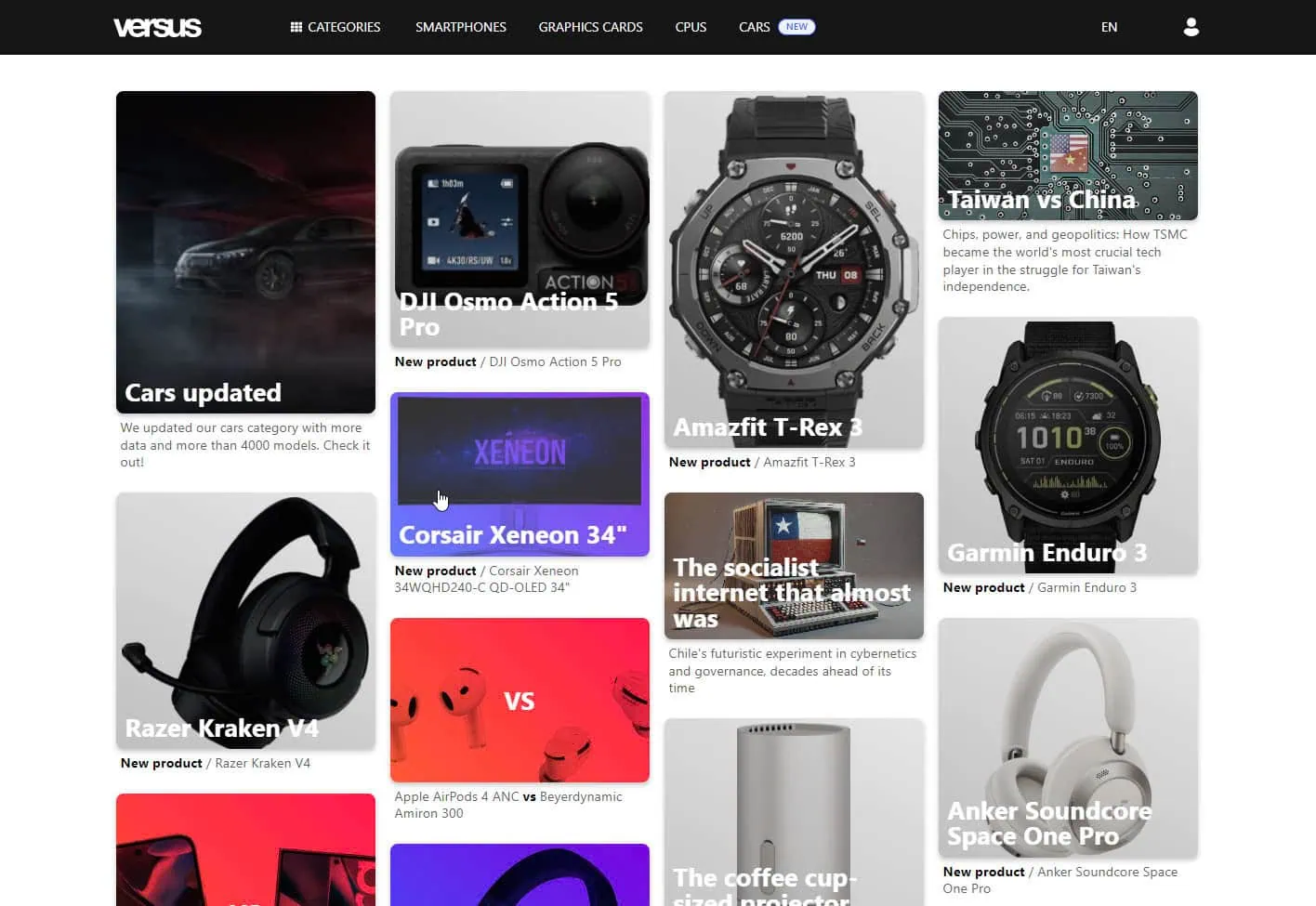
Type 4: Agency partners
Partnering with agency partners is beneficial for B2B and SaaS companies.
These agencies are knowledgeable about the B2B sales cycle or familiar with the SaaS industry. They have separate client networks and can leverage them to refer business customers to your brand.
To recruit them:
- Use Google search or LinkedIn to find affiliate marketing agencies that have experience in your industry.
- Join industry forums, events, or conferences. Look for brands with similar values or customer demographics. Ask them to collaborate and leverage each other’s customer bases to generate revenue.
Type 5: Email/ newsletter publishers
These affiliates create and send emails or newsletters to a list of their subscribers on a regular basis (daily, weekly, monthly, etc.). They aim to deliver valuable content to their built-in audience.
For example, if you provide productivity tools, lifestyle products or sell books, you can partner with Tim Ferriss. He sends out a weekly newsletter called 5-Bullet Friday. Each issue includes five short recommendations ranging from books and gadgets to travel tips and personal insights.
Identify popular publishing platforms like Substack, Medium, or Patreon. Next, find popular publishers in your field with many subscribers. Ask them to collaborate.

However, don’t just go to a large pool of affiliates and collaborate with all of them. Instead, focus on the quality of the potential partners you want to work with.
Before reaching out, here’s what you should consider when recruiting affiliate marketers:
- Niche relevance: Experienced affiliates in your industry can create better, more effective ads. Their campaigns will align with your products or services.
- Target audience match: Identify your ideal customer—their age, location, and interests. Then, look for influencers, content creators, and bloggers whose audience matches yours.
- Content quality: Check if your potential partners create high-quality content. It must resonate with your brand’s values and personality.
- Engagement rates: In addition to the number of followers, prioritize affiliates with high engagement metrics (likes, comments, shares, etc.). This shows that the affiliate’s audience is active and responsive.
After choosing the best affiliates to promote your products, group and segment them.
Affiliates differ in experience, audience size, and marketing methods. Their results vary, too.
Consider organizing your affiliates into groups by type or marketing platform. Then, you can create programs with custom commission structures for each group’s contribution.
Take FlasKap, a hydration company known for their innovative drinkware products, as an example.
After starting their first affiliate program with UpPromote, the brand reached out in various ways. They also used UpPromote’s Marketplace to find partners.
FlasKap now has a diverse group of over 200 affiliates. This includes influencers, review bloggers, and coupon partners. The brand has divided them into five groups. Each group has a unique commission structure. This structure depends on their traffic and sales contributions.

For instance:
- Coupon sites receive the lowest commissions. That’s because shoppers from these sites are typically ready to buy and simply seek the best deal.
- Influencers and ambassadors earn higher commissions. Since they introduce the brand to new audiences, they play a bigger role in driving awareness and interest.
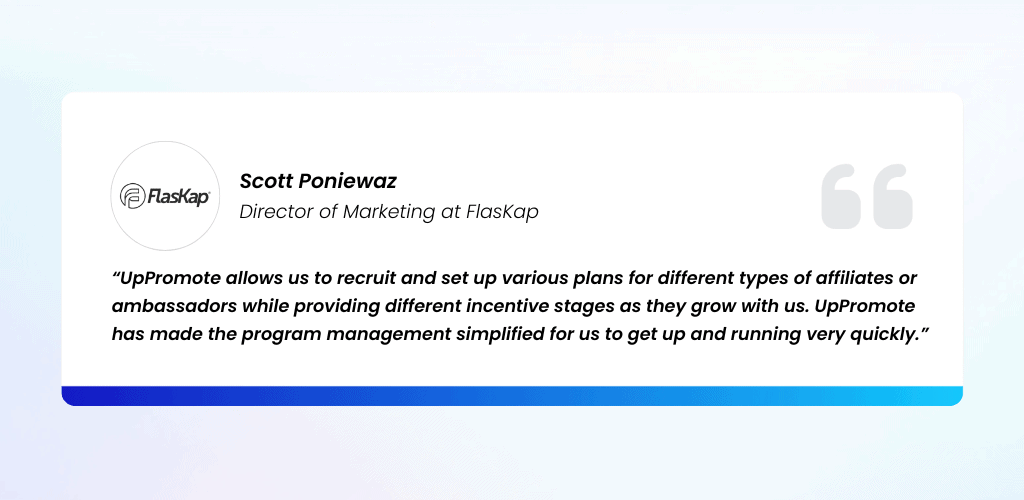
Turn on UpPromote’s dynamic settings and tailor programs for segmented affiliate groups.
2. Onboard Affiliates and Provide Training
One of the biggest mistakes merchants make is assuming affiliates will “figure it out” on their own after joining an affiliate program. The reality? Without proper onboarding and training, even the best affiliates won’t perform at their full potential.
After all, if affiliates don’t understand your products, how can they promote them the right way?
That’s why a well-structured onboarding process isn’t just helpful—it’s essential.
Let’s look at how a real brand got this right.
Oh My Mahjong (OMM) sells beautifully crafted Mahjong sets, accessories, and teaching materials for players of all levels.

Unlike everyday consumer goods, Mahjong is a traditional game that requires explanation. People won’t buy it on impulse—they need to understand the rules, the story, and the experience it offers.
That’s why OMM doesn’t treat affiliate training as optional. They don’t let just anyone promote their brand. Instead, their most impactful affiliate group—Mahjong teachers—must pass a knowledge test before joining. Once approved, they get a discounted “teacher kit” to help them educate others.
This might sound strict, but it works. These teacher affiliates now make up their most impactful partner group, driving around 10% of total revenue.
If their affiliates didn’t understand the game, they couldn’t sell it—simple as that.
Now let’s talk about how you can do the same.
Start your onboarding process with a warm welcome—personally thank each new partner for joining. Next, send a complete onboarding kit. It should have important product details, branding guidelines, commission structures, and marketing resources.
To help affiliates start quickly, offer step-by-step guides. Explain to them how to use the affiliate dashboard, track earnings, and access promotional tools.
Consider using different formats for training, such as:
- Email: Send detailed and helpful emails to provide affiliates with necessary information.
- Online learning portal: Create a site where affiliates can access materials at their own pace.
- Live webinars: Host real-time training sessions with Q&A.
- Video tutorials: Offer pre-recorded videos on how to get started.
With UpPromote, you can easily send welcome emails to new affiliates. Use our templates or customize your message to greet new partners.

Also, our app helps you give affiliates a detailed guide from day one. You can update a walkthrough video, notes, or announcements for partners. Your affiliates can see this in the Guide tab of the affiliate dashboard after logging in.
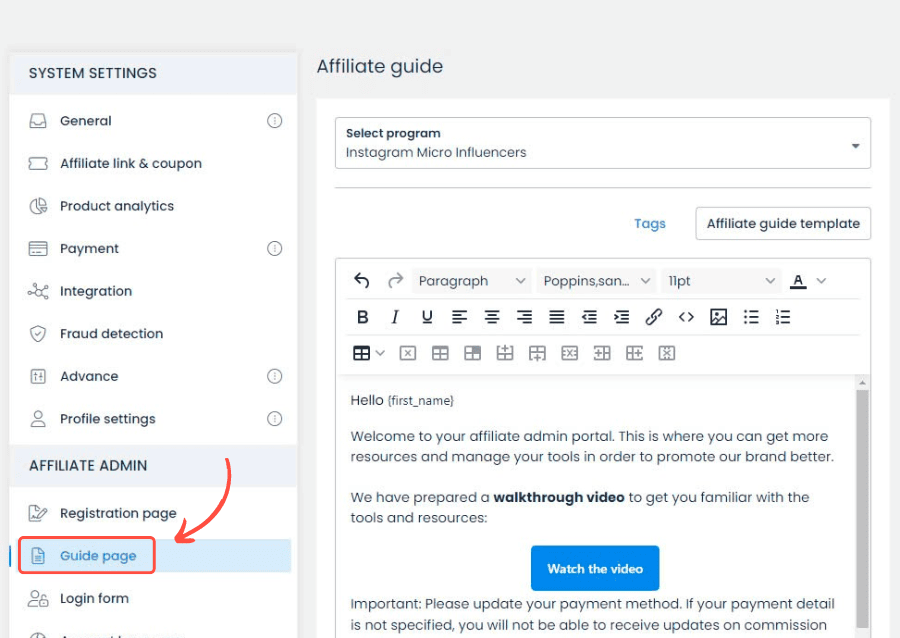
3. Empower Affiliates with Marketing Resources and Dashboards
To improve your partners’ work, give them high-quality marketing materials and a good working space.
- Offering affiliates with pre-made marketing assets can simplify their promotion efforts. These assets include banners, product images, social media posts, and email templates. This will save affiliates time and ensure they promote your brand with consistent messaging.
- Meanwhile, providing a user-friendly dashboard can help affiliates easily find everything they need, such as affiliate links, coupons, and program details. It also empowers them to track their success and use data to improve their performance.
With UpPromote, you can upload and organize media in the Media Gallery. This makes it easy for affiliates to find everything they need quickly and efficiently.
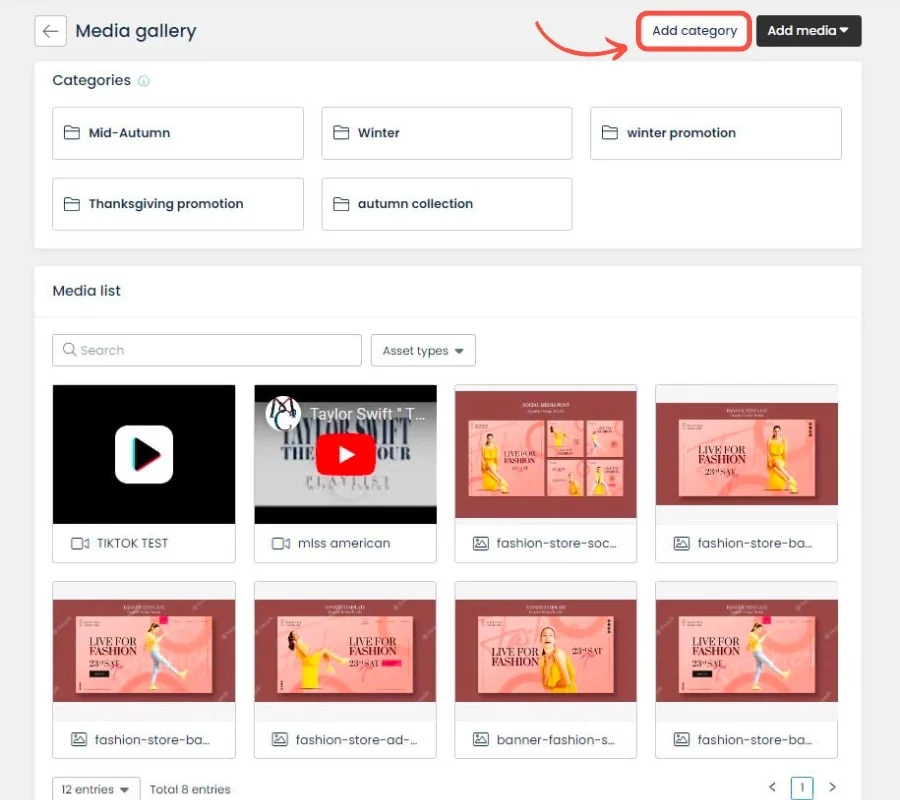
UpPromote also lets you customize affiliate dashboards. You can easily add your branding elements and improve your affiliates’ working experience. A clean, organized, and easy-to-navigate dashboard lets your affiliates access important info.
With the UpPromote affiliate portal, your partners can find:
- Affiliate links and coupons
- Media gadgets
- Detailed information & guide about your program
- Real-time tracking dashboard with clicks, sales, and commissions
Our affiliate app lets you add custom CSS. You can customize the affiliate admin page’s color or hide the affiliate link if you want to track conversions only by coupon codes.
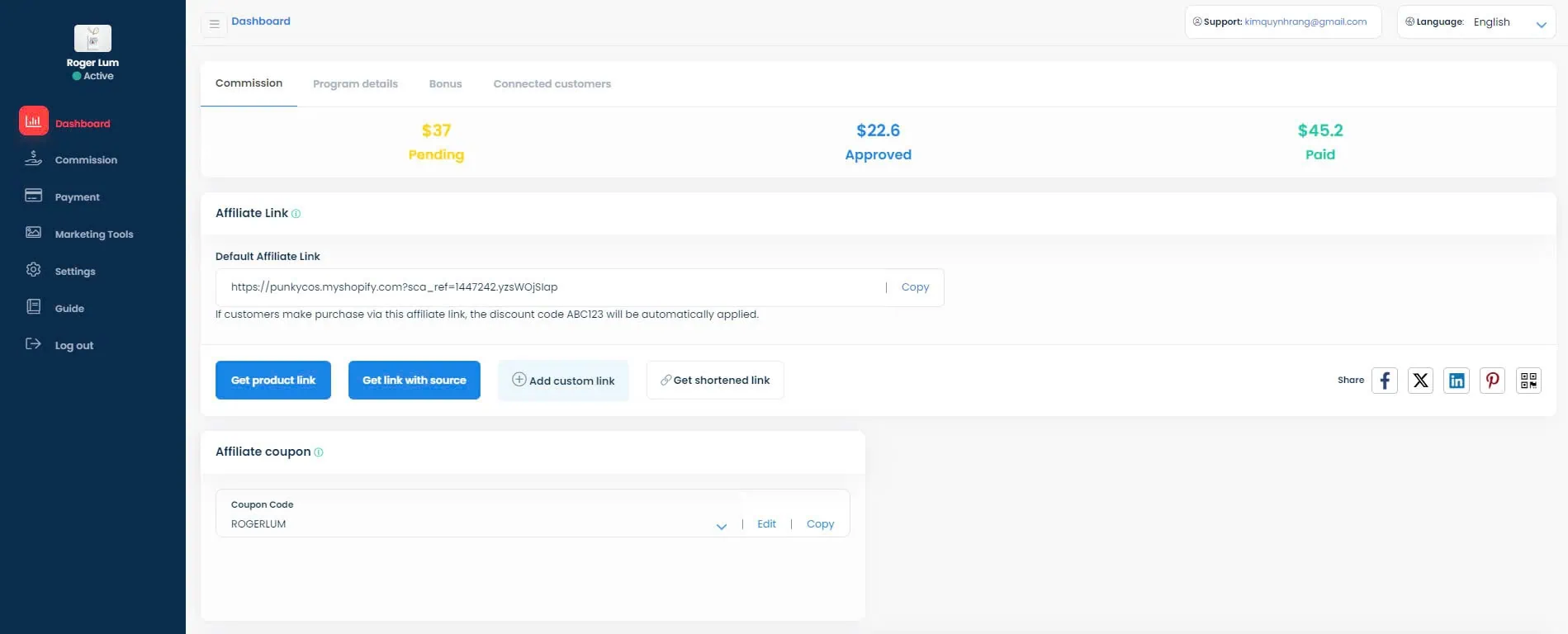
Kess Berlin, for example, leverages influencer marketing through UpPromote as a key strategy to introduce their beauty products to the world.

To support their Instagram influencers, Kess Berlin provides all the tools they need to promote their makeup line. They send out sample products directly to their influencers. These influencers test these products and then share their experiences. They can post on Instagram Stories and include affiliate links too.
Through these links, UpPromote automatically tracks every sale the partners generate. Influencers can also log in to their personal dashboards to monitor clicks, referrals, and commissions in real time.
In addition, Kess Berlin runs monthly campaigns to provide influencers with fresh content, special discount codes, and additional creative assets to share with their followers.
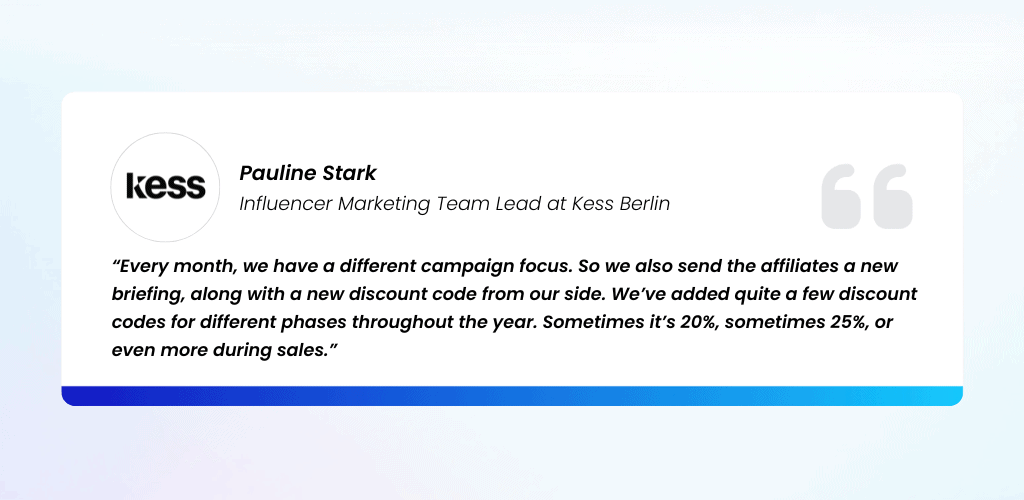
This consistent support not only empowers influencers but also ensures that Kess Berlin’s brand message stays aligned across channels, audiences, and seasons. It has contributed to impressive results: over 44,000 referrals generated by just 44 active influencers.
Give your affiliates the tools to win with UpPromote—so they can grow your brand and boost your bottom line.
4. Track and Optimize Affiliate Performance
A key to managing affiliates is to track and boost their performance. This helps you find which affiliates are performing well and pinpoints those who need support to improve results.
Review your goals and KPIs. Use them to measure success.
Focus on key affiliate metrics, including:
- Clicks and traffic: Check how much traffic each affiliate is sending to your store.
- Conversion rate: Monitor the percentage of clicks that result in actual sales.
- Sales and revenue: Track affiliate sales and the revenue they generate.
- Average order value (AOV): Measure the average value of orders made through affiliate links or coupons.
- Return on investment (ROI): Compare the profit from your affiliate program to its costs.
- Customer lifetime value (CLV): Calculate the long-term worth of customers brought in by affiliates.
Whether you’re running an affiliate program for a small business or a large company, using a reliable affiliate tracking app is essential for tracking affiliate sales automatically and accurately. It provides real-time data and detailed performance reports for review and optimization.
If you use UpPromote, our affiliate software offers various tracking methods, helping you monitor your affiliates’ performance closely.
You can track key details. These include the number of affiliates, orders, commissions, and referral sources. You can also view real-time reports in graphs, charts, and tables.
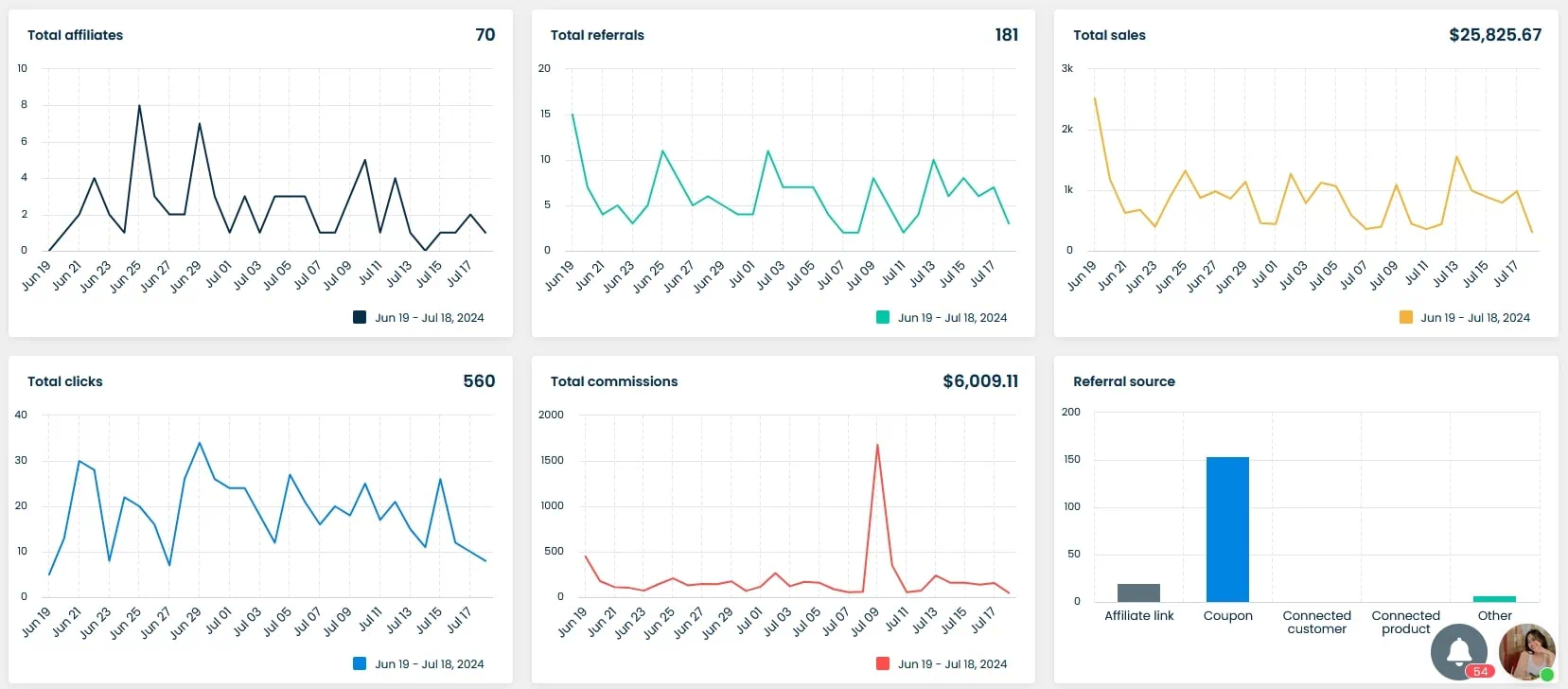
The affiliate analytics will show you which affiliates are excelling. Check the Top Affiliates board for the results.
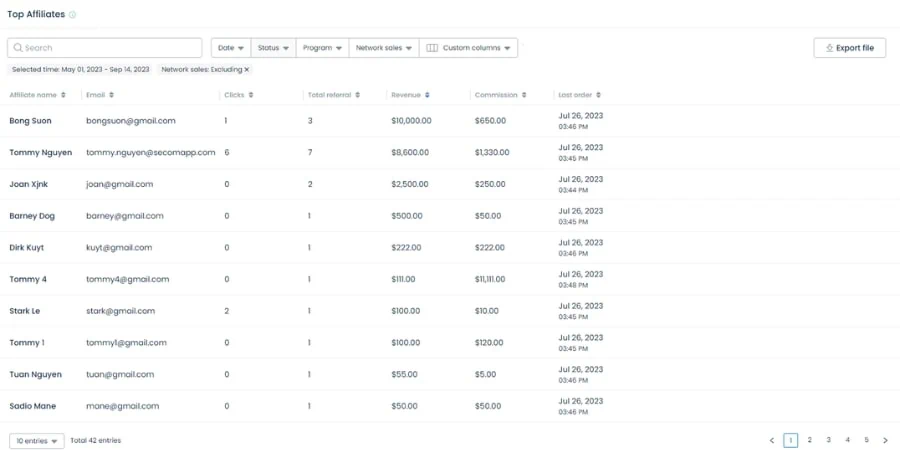
By tracking affiliate performance, you can see what works and find areas to improve. From there, you can make data-driven decisions to optimize your campaign, such as:
- Ask affiliates who missed their targets about any issues. Offer support.
- Adjust rewards based on affiliate performance. This will keep your top partners engaged and motivated.
- Test different commission rates. Find the best ones to motivate affiliates
5. Communicate and Build Strong Relationships
Effective communication is essential. It builds strong, lasting partnerships with your affiliate marketers.
Here are some tips to help you communicate better and strengthen the affiliate relationships:
Regular updates
Frequently contact your affiliates via email, message, or call. Share updates on your affiliate program, new collections, marketing tools, or promotions with them. Ask for their suggestions or brainstorming ideas to promote your products more effectively.
Personalized communication
Give feedback based on individual performance. Address their strengths and areas for improvement.
Build an affiliate community
Create a social media group, a forum, or host regular webinars. These will let affiliates share tips, success stories, and challenges with each other.
Celebrate affiliate success
Recognize and celebrate the achievements of your affiliates, both publicly and privately. Send a thank-you message when they generate excellent sales. Give them bonuses or public shout-outs in newsletters or your community group.
Provide ongoing support and resources
Regularly check in with your partners. Ask if they have questions or concerns to give them timely support. Make sure your affiliates have access to updated marketing materials and tutorials.
With UpPromote, you can easily connect and communicate with your affiliate partners. There are two options available for your preference:
- In-app chat: You can send direct messages to affiliates within the app.
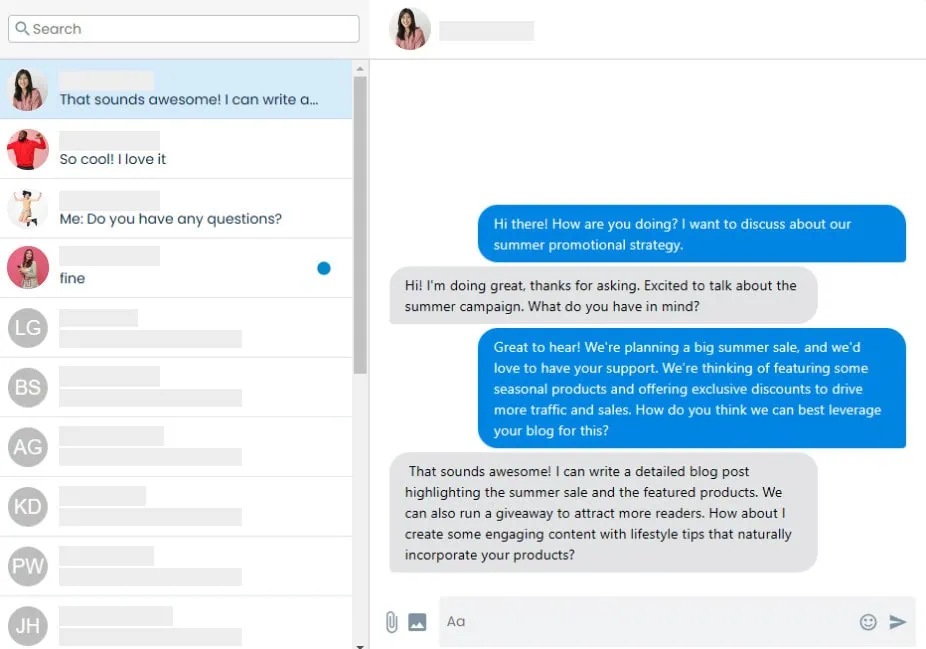
- Email: To reach more affiliates quickly, customize our templates. Then, send bulk emails to inform them of any changes in your program.

6. Incentivize and Reward Affiliates
Your affiliates don’t all perform at the same level.
So what happens if you pay every partner the same rate, whether they bring in 10 customers or 1,000?
It doesn’t just limit your brand’s growth but also discourages your top performers from going the extra mile.
That’s why you need to build in strategic incentives—to reward results, fuel healthy competition, and recognize those who truly stand out.
Here are a few proven ways to incentivize your affiliates:
- Performance-based bonuses:
Offer cash rewards to affiliates who hit specific goals like total sales, referral count, or commission earned. This not only encourages short-term growth but also gives affiliates something concrete to work toward.
With UpPromote, you can easily identify top performers and send bonuses directly through the app. You can customize the criteria, frequency, and bonus types to match your goals, all within just a few clicks.
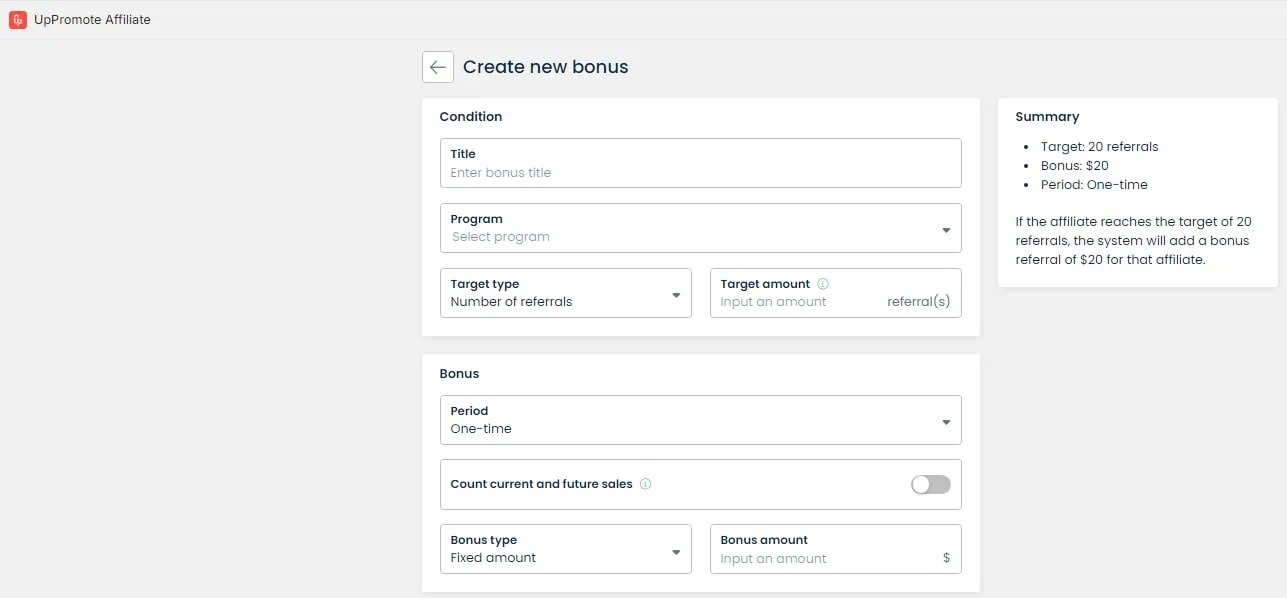
- Tiered commission structures:
Reward high performers by increasing their commission rates as they drive more sales.
This motivates affiliates to move up the ranks, knowing their efforts will be rewarded with higher earnings.
That’s exactly what Tréskin, a popular skincare brand in the U.S., does using UpPromote. They offer four commission levels, allowing affiliates to earn between 20% and 35%, depending on their performance.
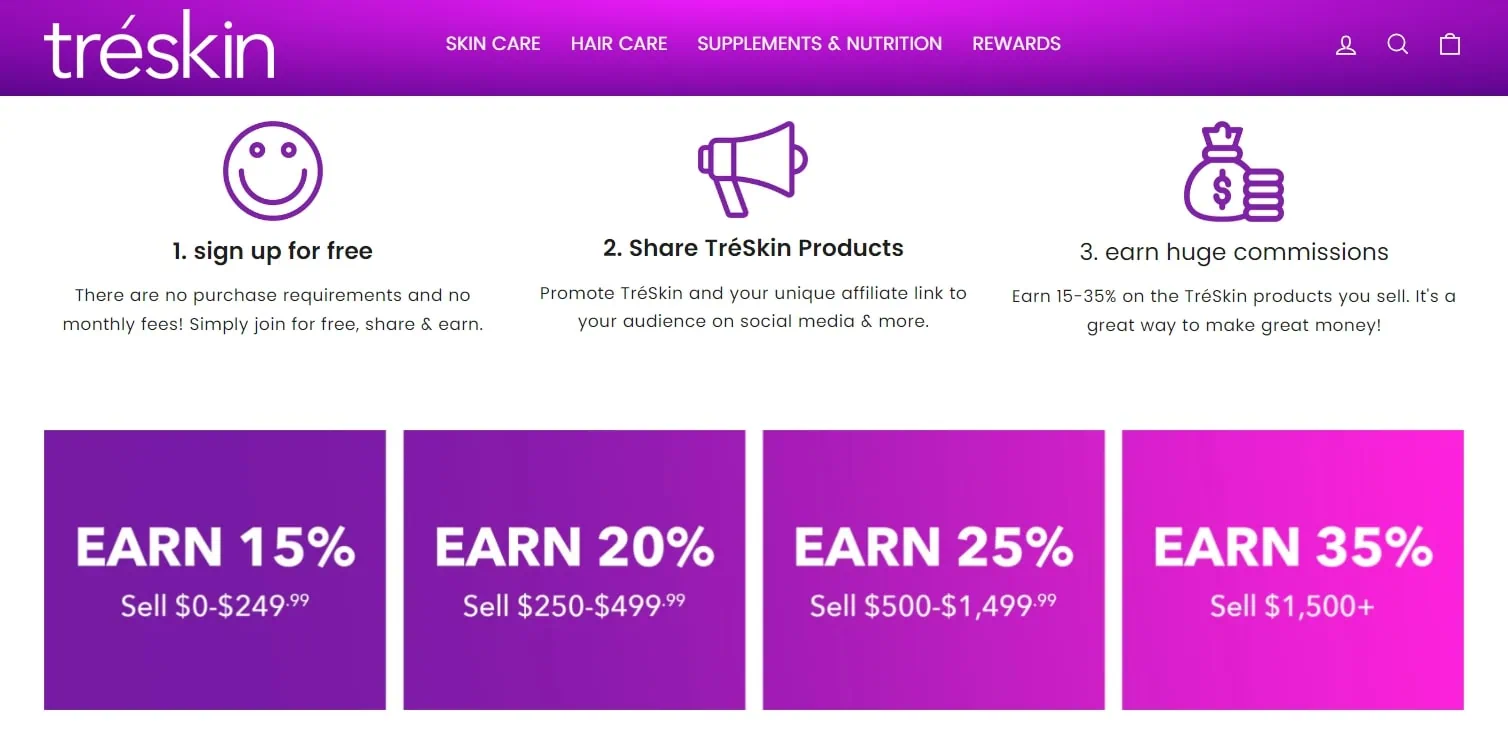
This smart strategy helped motivate their affiliates to push harder and played a key role in driving over $120,000 in affiliate revenue within a single quarter.
With UpPromote, tiered commissions are highly flexible. You can set them based on total order value, item quantity, or other performance metrics.
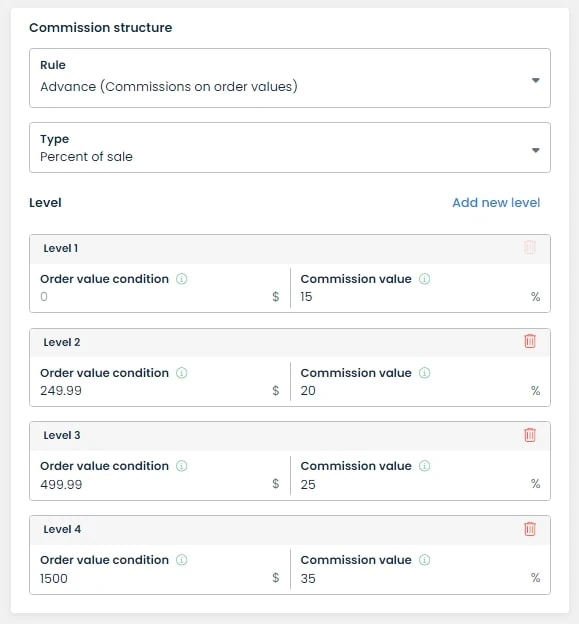
- Affiliate contests:
Turning your program into a game is a great idea. Run monthly or seasonal contests that reward your most active affiliates with cash prizes, gift cards, or exclusive perks.
Take CrakRevenue, a well-known CPA network, as an example. Their contests energize the community, offering top performers not only monetary prizes but also unique rewards like gadgets and experiences.
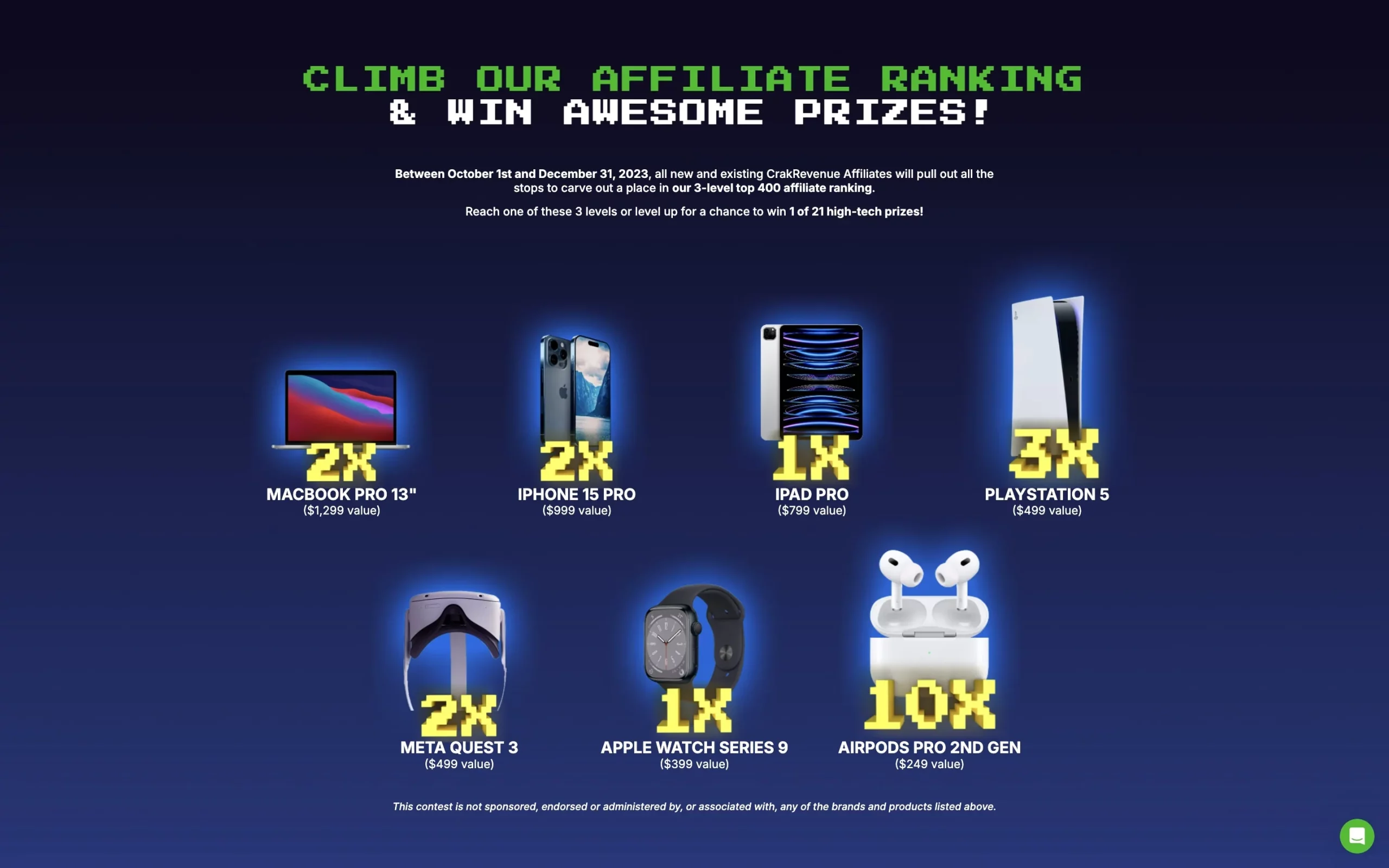
- Other types of reward:
Not all rewards need to be monetary.
Consider offering personalized incentives based on an affiliate’s preferences, such as gift packages, early access to new products, or exclusive discounts.
With UpPromote, you can easily send surprise gifts to your top-performing affiliates.
Once you identify high performers, simply activate UpPromote’s gift feature to design and deliver custom reward packages that show your appreciation.
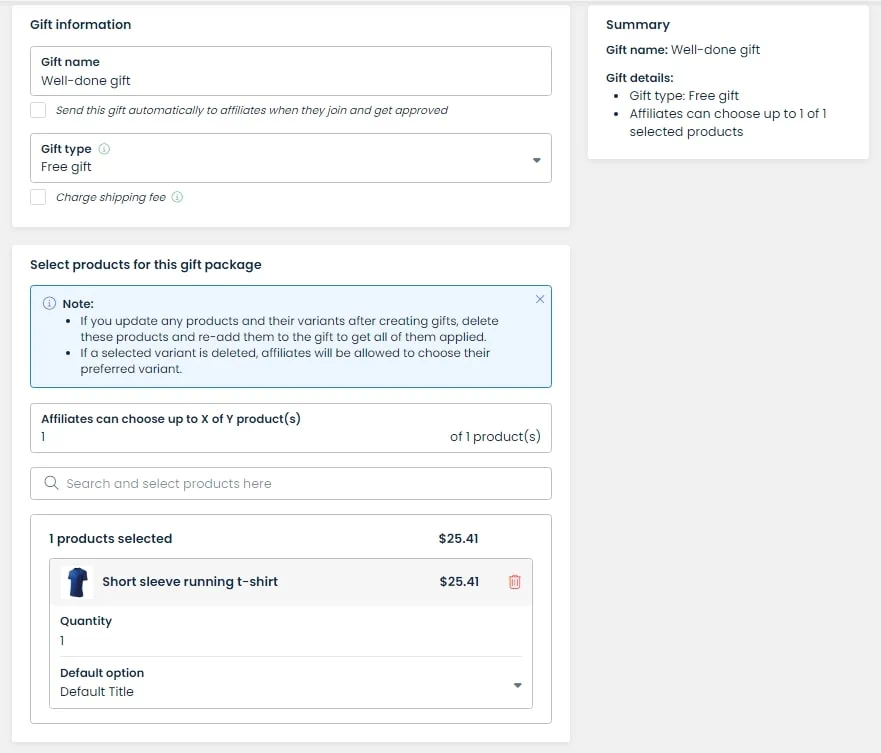
Activate UpPromote’s powerful settings to & customize dynamic incentives to boost affiliate engagement.
7. Prevent Fraud and Manage Risks
Fraud in affiliate marketing occurs when an affiliate marketer uses deceptive or fraudulent tactics to increase their earnings from your campaign. These activities can cause financial losses and false data in your affiliate marketing reports.
Affiliate fraud can cost businesses billions of dollars each year. According to the leader cybersecurity company CHEQ, ad fraud accounted for 17% of all affiliate traffic and caused $3.4 billion in losses in 2022.
As an affiliate manager, it’s important to be aware of common scams and act to eliminate them.
Affiliate fraud can take many forms, so watch out for these common types:
- Click fraud
- Fake leads
- Cookie stuffing
- Purchase fraud
- Affiliate hijacking
To protect your affiliate program from scams, here are some tips for you:
Set clear terms and conditions
Clearly outline your program’s rules and expectations. List prohibited practices, like misleading ads and spam. Specify consequences for violations. Include cookie expiration policies to prevent fraud.
Monitor affiliate data closely
Track traffic, earnings, and conversions by affiliate account. Watch for unusual changes, such as sudden spikes in clicks or conversions. Carefully cross-check and compare data through reports to identify suspicious activity.
Use fraud detection tools
Invest in solutions that automatically identify red flags, like cookie stuffing or repeated invalid clicks. Free affiliate tracking software with fraud detection will be very useful for your brand.
Penalize fraud
If you find fraud, act quickly to avoid further damage. For example, withhold commissions, impose fines, or remove the affiliate from your program. Consider seeking legal advice to ensure the proper action is taken.
That’s exactly what Apollo Scooters did when they noticed a rise in self-referral abuse.
While they continue to work closely with high-performing partners, some individuals have tried to game the system—buying scooters through their own affiliate links and stacking both commission and discount.
To keep things fair, Apollo becomes more selective about whom they approves. They now prioritize affiliates who reach out directly with proof of audience or demonstrate genuine interest.

UpPromote supports Apollo in safeguarding their program by detecting multiple signups from the same IP address. Suspicious behavior is automatically flagged and removed.
Additionally, UpPromote enables the brand to block self-referrals by excluding commissions from purchases made through an affiliate’s own link or coupon.
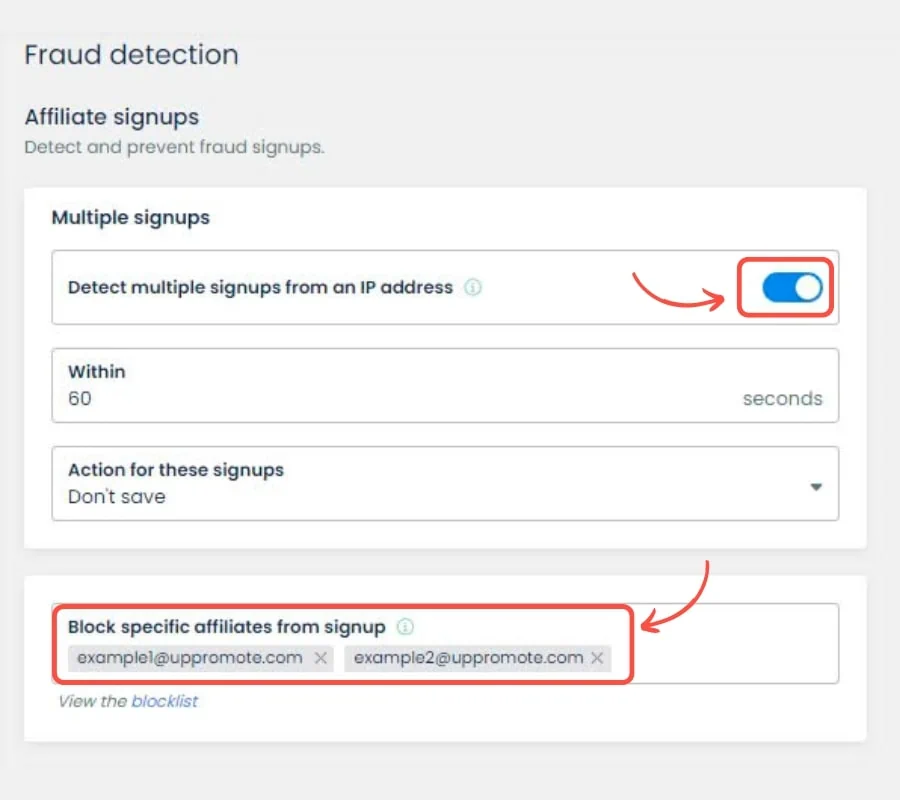
As a result, Apollo now runs a more secure and transparent program, focusing on quality partners who truly help spread the word.
Protect your affiliate program from fraud and stay in control with UpPromote.
8. Address Legal and Compliance Considerations
Compliance in affiliate marketing is vital. It avoids legal penalties, prevents affiliate disputes, and builds partner trust.
Here are key factors that you should keep in mind:
- Follow data privacy and advertising regulations. For instance, comply with GDPR (General Data Protection Regulation) in the EU or CCPA (California Consumer Privacy Act) in California. Adhere to FTC (Federal Trade Commission) guidelines in the U.S. to maintain transparency in affiliate promotions.
- Draft legal documents that clearly state the terms and conditions of your affiliate program. Covering the enrollment process, affiliate responsibilities, promotional rules, commission structures, and payment methods. Be sure to include confidentiality, proprietary rights, and termination terms.
- Keep taxes and invoices clear. Affiliates must know their tax duties and provide the right documents, like W-9 forms in the U.S. or the EU format.
Bonus tips:
- Consult a legal expert. They can ensure your affiliate program and agreements follow all laws and regulations.
- For taxes and invoices, use an accounting or affiliate tool. It will save time and reduce errors through automation.
With UpPromote, you won’t worry about taxes or invoice issues.
Based on your setup, you can decide who will handle tax payments—either you or your affiliates. Then, simply enter the applicable tax rates according to local regulations. The system will automatically calculate taxes for payouts, eliminating the need for manual input.
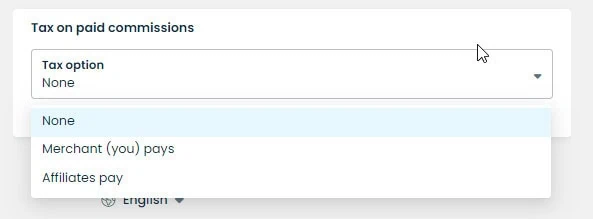
At the same time, you can enable the Export Invoice function. To meet regional requirements, you can choose either the default invoice or the EU format. Both you and your partners can download invoices for paid referrals.
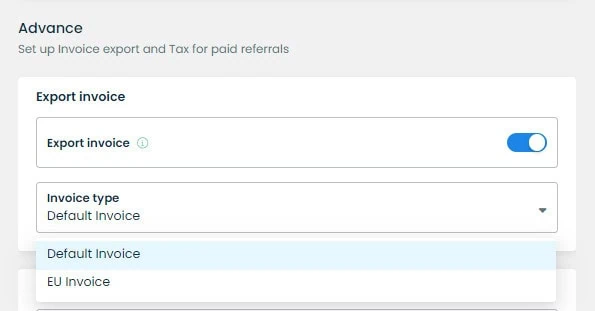
The invoices will include Invoice ID, Payment method, Payment info, Payment amount, Affiliate name, and Referral details.
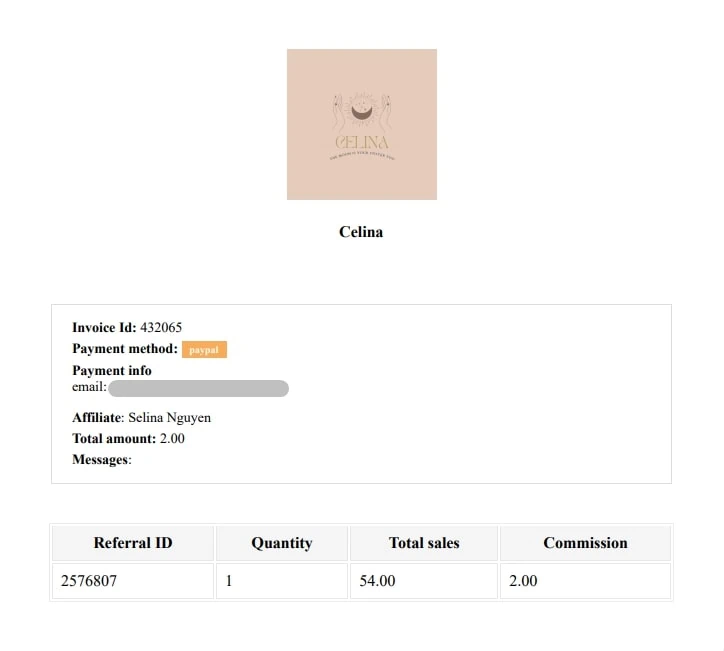
Best Practices for Affiliate Marketing Program Management
Smart tactics can make a big difference in how well you manage an affiliate program. They can be the key to success or failure.
By applying best practices, you’ll have better control over your partners and get the most out of your program.
Set Clear Goals and Expectations
Clearly defining your goals for the affiliate program is essential in your role as an affiliate manager. This lays the foundation for everything that follows, keeping your program on track. Are you looking to:
- Increase sales for your store?
- Boost sales for a specific product?
- Bring more visitors to your website?
But don’t stop there. You need to set specific targets to guide your program. Consider using the SMART model: Specific, Measurable, Achievable, Relevant, and Time-bound. It can help make this process easier. For example:
- Grow total sales by X% next quarter by teaming up with Y new affiliates.
- Increase sales of Product B by X% next month with a special discount code for Y influencers.
- Bring in X new visitors over 3 months by working with Y bloggers.
Then, clearly share these goals with your affiliates. Track relevant KPIs to check progress closely.
Leverage Affiliate Management Tools
Choosing the right affiliate software will help you manage affiliates better. It will simplify multiple tasks through automation.
A good affiliate management tool should provide:
- Automated tracking and affiliate sales attribution
- Automate payout process
- Real-time analytics and reports
- Reward management
- Fraud detection
- Scaleability
For a powerful solution that meets all the criteria, check out UpPromote. More than 115,000 users worldwide trust the app to manage their affiliate programs.
You can use UpPromote without worrying about upfront costs. Start with $0 and scale up anytime as your affiliate program grows.
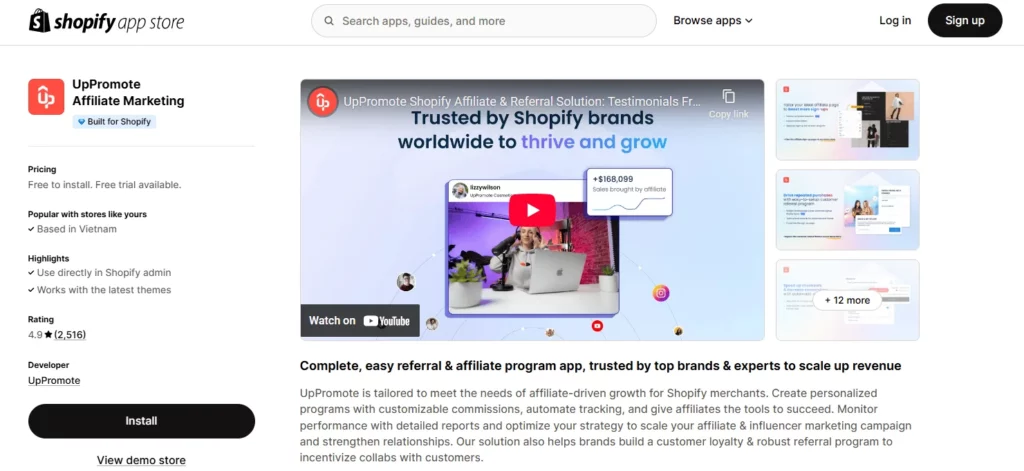
Stay Updated on Industry Trends and Best Practices
The affiliate marketing landscape is constantly evolving. Stay updated on the latest trends, best practices, and new tools in your niche to create long-term success for your program.
Here’s how you can do that:
- Follow industry leaders’ or influencers’ posts on Twitter, LinkedIn, and YouTube
- Join online communities on Reddit or LinkedIn related to affiliate marketing
- Attend niche events and webinars to learn from experts and network with peers
- Read articles or subscribe to newsletters from industry experts
For example, you can explore MarketingProfs for useful marketing resources. The platform offers content in many forms to help you better market your products and services. These include blog posts, webinars, online events, forums, and courses.
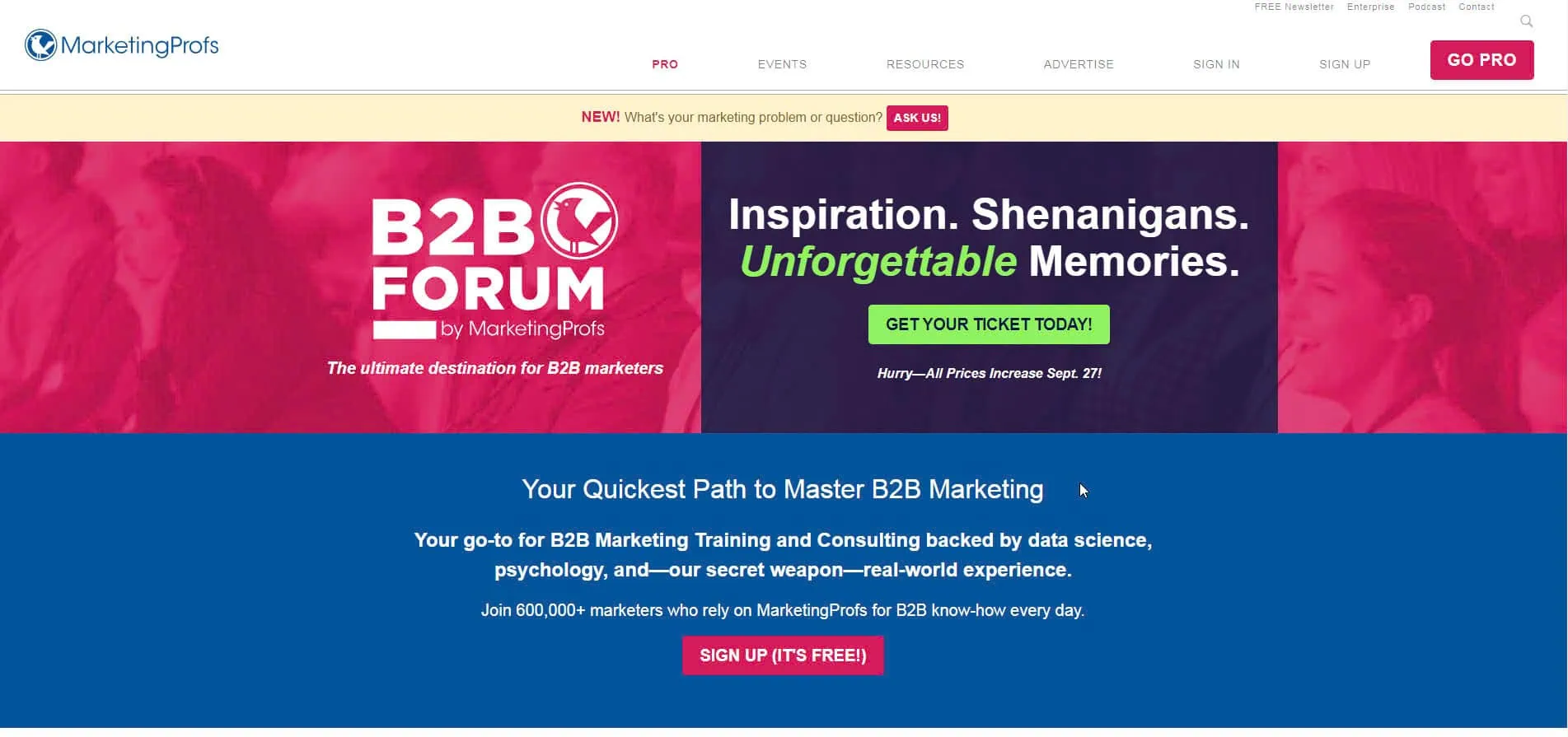
Successful Affiliate Program Management Examples
A great way to improve your work is to learn from successful affiliate management examples. This approach can help you uncover proven strategies and select the best ones for your campaigns.
Here are some real case studies to check out:
Window Cleaning Resource
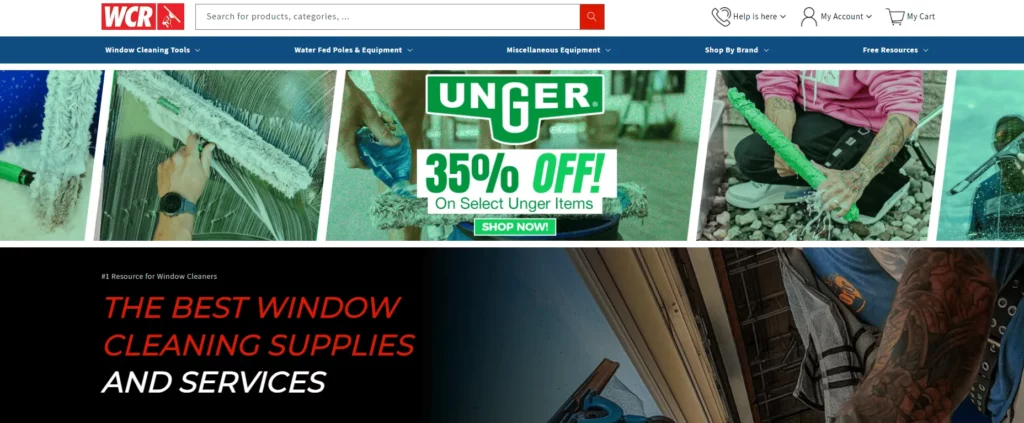
Window Cleaning Resource is a well-established brand that provides tools, education, and community support for professional window cleaners.
They have leveraged UpPromote to run and manage their affiliate efforts effectively. With a smart approach to affiliate growth, the brand has:
- Built a network of over 250 active affiliates
- Reached 80% of their $1M affiliate sales goal in just 6 months
Here’s how they do it:
- Tap into their existing community of window cleaning professionals. Engaged forum members, customers, and YouTube viewers become trusted affiliates through authentic connection and shared experience.
- Recruit affiliates from within, starting with employees and sales reps. These individuals already understand the products and are able to promote them with credibility.
- Segment their program into Pro, Basic, and International tiers. Each tier has a tailored commission structure based on performance level, location, and logistics.
- Build strong personal relationships with affiliates by sending welcome swag packages. Ongoing one-on-one communication ensures partners feel supported and stay motivated from day one.
Holbrook Pickleball

Holbrook Pickleball is a brand that provides high-quality pickleball paddles and gear for players of all levels.
By effectively managing its affiliate programs, the brand achieved impressive results:
- Orders through affiliates increased by 87% by the end of 2023
- Affiliate revenue rose by 86% in just one year
Below are the strategies Holbrook puts into action:
- Create three distinct programs. One for regular ambassadors (recreational pickleball players, coaches, and brand fans). A separate program for professionally sponsored athletes. And another for YouTube influencers.
- Motivate affiliates with monthly sales contests. Affiliates who meet monthly sales goals can win prizes such as products or bonuses.
- Host webinars regularly to update, share best practices, and answer questions. This also enhances the chance for ambassadors to interact with the Holbrook team and each other.
- Closely track affiliate sales through UpPromote’s analytics dashboard to identify high-achieving affiliates. Then, quickly reward them with gift packages using UpPromote’s gift feature.
Final Words
Effective affiliate program management is key to your success. It helps you stay in control. You can see how things are going and spot areas that need improvement.
Managing an affiliate program is ongoing. We hope this guide shows you how an affiliate manager can get the best results.
Use reliable affiliate marketing software along with smart strategies for managing your affiliates. It can make the whole process easier and less overwhelming.




